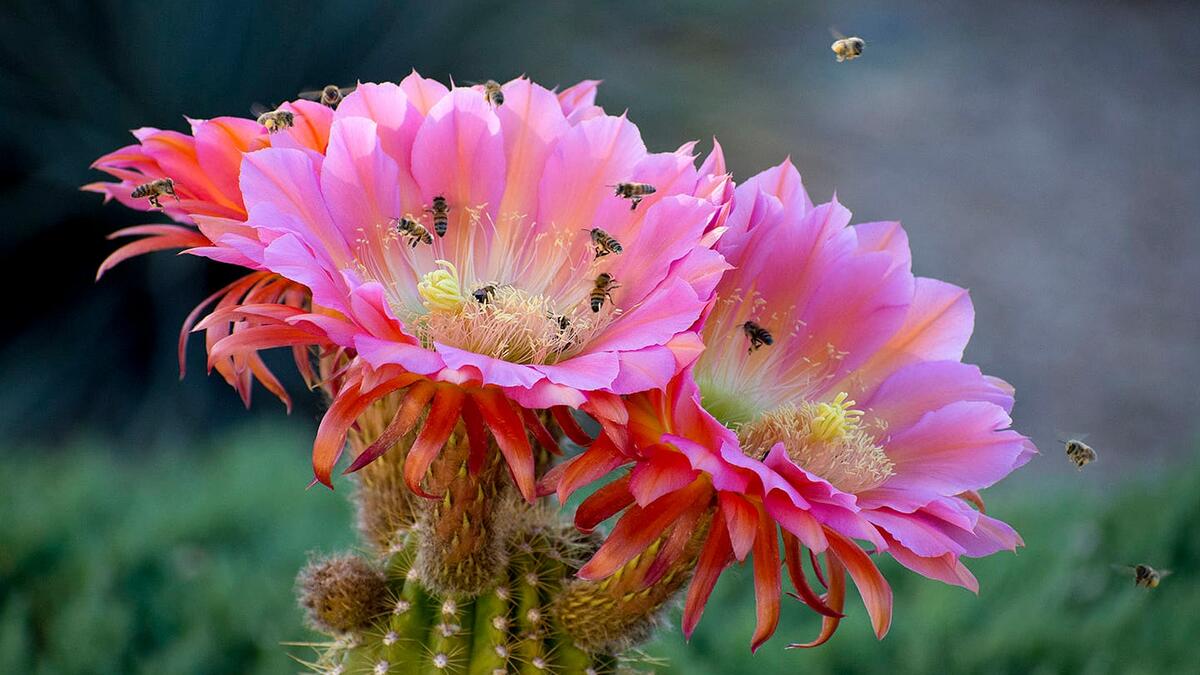Honey bees can handle the heat, but that still may not save them from climate change

Photo courtesy Jon Harrison
Living in Arizona, we all know how hard it is to stay active when it gets too hot outside. Honey bees, though, have some nifty tricks to work around the heat, according to a new study published in the Proceedings of the National Academy of Sciences (PNAS) by Jordan Glass, who received his PhD from Arizona State University last spring.
Glass’ team found that when it’s hotter outside, honey bees can adjust how they fly, using larger, more powerful wingbeats that require them to beat their wings less frequently to get to where they need to go — like the human equivalent of running with longer strides. Flying that way helps them keep their body heat at a lower temperature, allowing them to carry lots of nectar even when it’s hot outside.
This is an important adaptation for foraging honey bees, who unlike other insects, can’t just wait until it’s cooler out to start foraging. A honey bee’s colony relies on her to go out and forage all the time, so she has to be able to press on no matter the temperature for the good of the hive.
However, heat isn’t the only risk that honey bees must work around, Glass warns. For decades, many researchers have focused on studying the hottest and coldest temperatures that certain animals can function at. But Glass explains that there are plenty of other environmental factors that can affect honey bees’ behavior before they reach their temperature limits.
“The most important and most exciting thing that we found is that in these hot, dry, environments, it’s desiccation, and not heat (that puts honey bees at risk).”
Another way bees work through the heat is by releasing body moisture to cool off, like sweating. But letting go of too much moisture can be dangerous, as bees can only lose so much water before they desiccate –– or dry out –– and lose their ability to function. That danger is heightened when it’s both hot and dry out, Glass’ team found, as bees who would normally release moisture to cool down will be put at a greater risk of drying out in doing so, especially with less sources of water around.
As certain areas get hotter and drier due to climate change, with 2023 being the hottest year ever recorded, bees will have a harder time foraging, endangering their populations. That can have consequences for humans, too.
“For us, as people who eat things that these (honey bees) pollinate for us ... it can have a big effect on food security,” Glass said.
Glass conducted this research with Arizona honey bees in mind, having grown up in the hot, dry state himself.
“I grew up in Arizona. I understand the heat. I understand that it gets pretty intense. And I know we have honey bees there, and we have some crops that rely on them, and so I thought it would be really interesting to look at what environmental factors limit when they can be active,” he said.
Glass didn’t always know that he would end up focusing on honey bees. Rather, he was drawn to do research on the effects of temperature on animal behavior, after finishing his master’s research investigating how temperature differences influenced crickets.
“That project and experience kind of spurred my love in understanding temperature," he said. "Temperature is the most influential abiotic factor that determines a lot of what (animals) do. Nothing can really escape its impact. And we are seeing increases in not only average temperatures each year, but the frequency of heat waves and cold snaps.”
After deciding to do his PhD at ASU, Glass landed on studying honey bees after recognizing that researchers didn’t know much about why the insects are active at different temperatures. His newly published research, which he conducted on ASU’s Tempe campus as well as at the University of California, Davis, shed light on that question by considering various kinds of cooling mechanisms that bees have.
Overall, Glass ended up enjoying working with what he calls “the adorable little pollinators.” In his years of studying them, he only ever got stung once –– right between the eyebrows. “Honey bees –– those ladies are feisty,” he jokes.
Now, as a postdoctoral researcher at the University of Wyoming’s Department of Zoology and Physiology, he continues studying how various species of bees adjust their behaviors in different environments. Hopefully, his research will continue to reveal whether these crucial insects will be able to adapt to their changing environments, and if humans can do anything to help.
More Environment and sustainability

A 6-month road repair that only takes 10 days, at a fraction of the cost? It's reality, thanks to ASU concrete research
While Arizona’s infrastructure may be younger than its East Coast counterparts, the effects of aging in a desert climate have begun to take a toll on its roads, bridges and railways. Repairs and…

Mapping DNA of over 1 million species could lead to new medicines, other solutions to human problems
Valuable secrets await discovery in the DNA of Earth’s millions of species, most of them only sketchily understood. Waiting to be revealed in the diversity of life’s genetic material are targets for…

From road coatings to a sweating manikin, these ASU research projects are helping Arizonans keep their cool
The heat isn’t going away. And neither are sprawling desert cities like the metro Phoenix area.With new summer records being set nearly every year — 2024 was the warmest year on record for…


